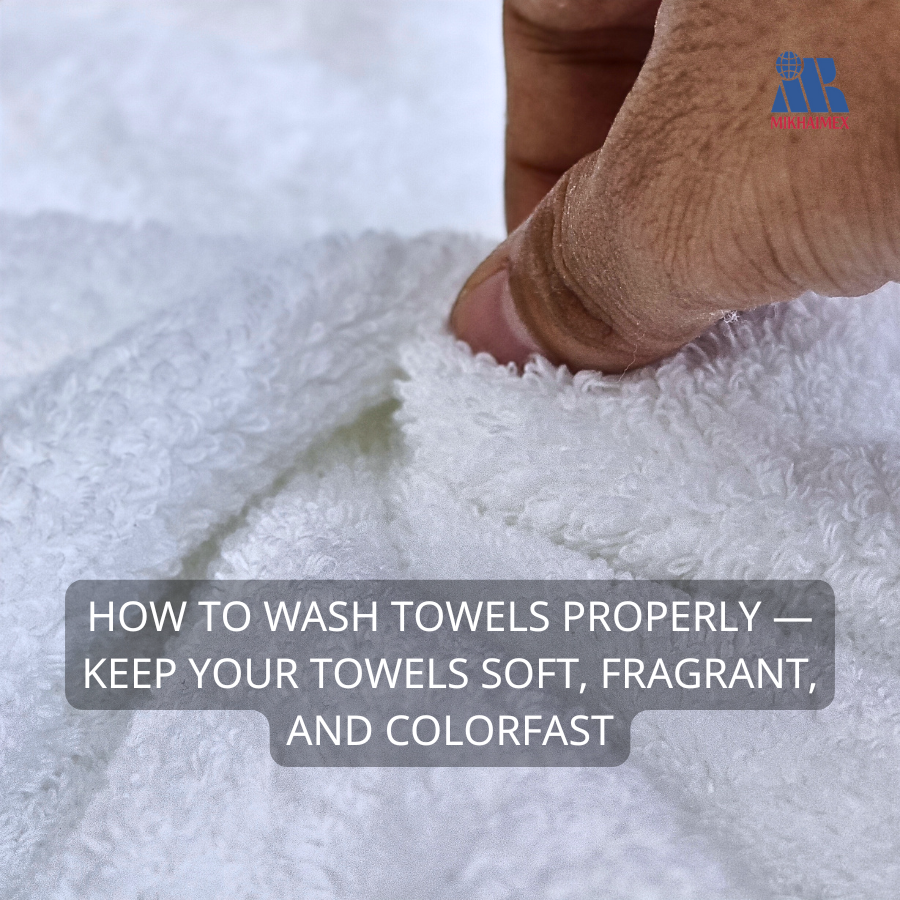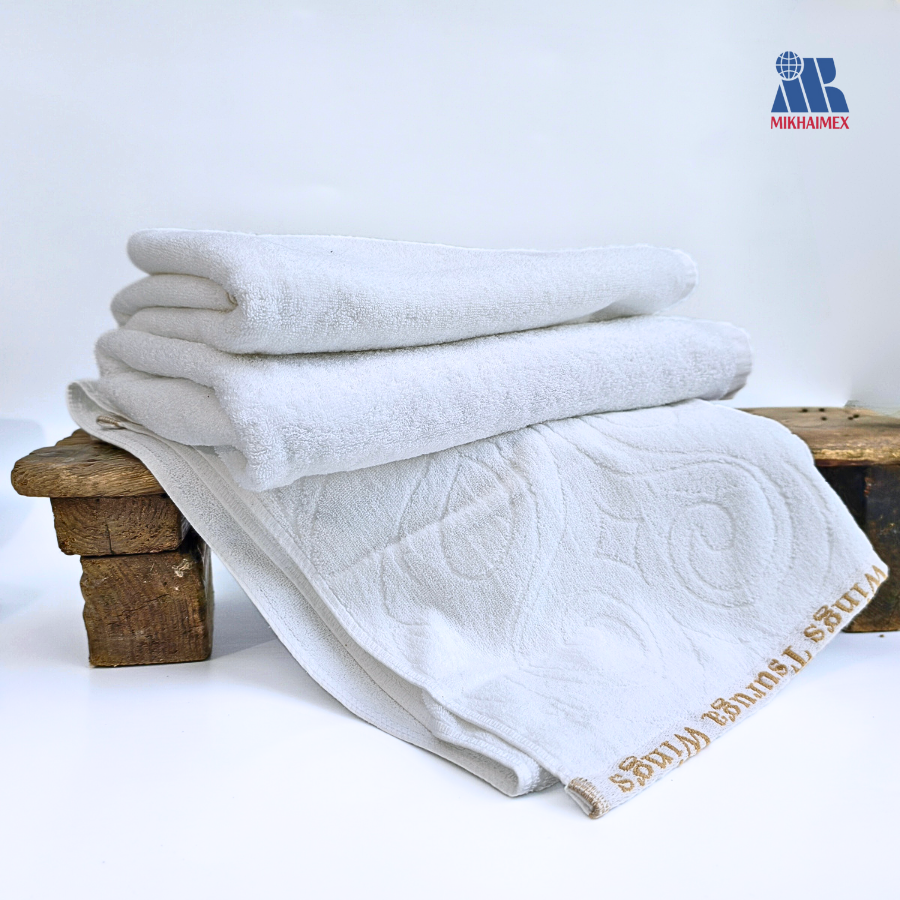HOW TO WASH TOWELS PROPERLY — KEEP YOUR TOWELS SOFT, FRAGRANT, AND COLORFAST
Towels are everyday household items in every home — from small face towels to bath towels, hand towels, or those used in spas and hotels. However, not everyone knows that how to wash towels properly directly affects the quality and durability of the product. A towel can retain softness, good absorbency, and a pleasant fragrance for a long time if it is washed and stored correctly. Conversely, if washed incorrectly, a towel can easily become dry and stiff, pill, fade, or lose its absorbency. This article will share detailed instructions on how to wash towels properly so you can care for your favorite towels effectively and economically.
1. Why you must know how to wash towels properly

Many people think that washing towels only requires putting them in the machine and selecting a normal cycle. That is only partly true. In fact, how to wash towels properly greatly influences the fiber structure, absorbency, and softness of the towel. If washed incorrectly, cotton fibers can be damaged, causing a rough feel and reducing the product’s lifespan.
Towels are made from natural cotton fibers with strong moisture absorption, so they can easily harbor bacteria and mold if not washed clean and dried completely. Therefore, washing correctly removes dirt, dead skin cells and excess oils from the skin, while keeping towels fresh, soft, and safe for the skin — especially for sensitive skin.
Washing properly also saves replacement costs. For service establishments such as spas, hotels, or health centers, applying the correct how to wash towels properly routine helps towels remain bright, hygienic, and gives customers a professional impression.
2. Preparation before washing towels
Before you begin washing, pay attention to sorting and preparation. This first step is very important in how to wash towels properly. Separate colored towels from white ones to avoid color transfer. Absolutely do not wash towels together with clothing — especially jeans, jackets, or garments with metal zippers — because strong friction will cause towel fibers to pill and weaken.
When washing newly purchased towels, wash them separately for the first 2–3 times to remove spinning dust and sizing residues left from weaving and dyeing. This helps the cotton fibers expand evenly, become softer, and improve absorbency.
Choosing detergent is also an important factor in how to wash towels properly. Opt for a mild detergent without strong bleaches or heavy fragrances. Strong powdered detergents can damage the cotton fiber structure. A small tip many people use is to add a little white vinegar or baking soda to the wash; these help deodorize, disinfect, and naturally soften towels.
Additionally, keep the wash water temperature at 30–40°C. This is the ideal range to remove dirt while preserving the elasticity and color of cotton fibers. Using water that is too hot can cause cotton to shrink and colors to fade quickly.
3. Instructions on how to wash towels properly
There are two common methods: hand washing and machine washing. Whichever method you choose, it is important to follow correct steps so you don’t damage the cotton fibers.
For hand washing, soak towels in warm water mixed with mild detergent for about 10–15 minutes. Then gently squeeze to remove dirt — avoid vigorous twisting because that easily breaks fibers. Rinse repeatedly with clean water until all soap is gone. In the final step, you can soak the towels in a little white vinegar to help soften them and completely remove soap residue. This manual method is time-consuming but very effective for premium towels.
For machine washing, select the delicate or gentle cycle. Do not wash towels with coarse clothing or sharp-edged items. Many people mistakenly think fabric softener makes towels softer and more fragrant, but in reality fabric softeners leave a thin coating around cotton fibers, reducing absorbency. To keep towels soft without fabric softener, try using vinegar or baking soda wash tablets. These natural agents both deodorize and help cotton fibers retain elasticity.
By following the correct how to wash towels properly routine, you will find towels become softer, less fuzzy, and retain their natural fragrance longer compared to incorrect washing.
4. Drying and storing towels after washing
Drying is an equally important step in how to wash towels properly. Towels should be hung to dry in a well-ventilated place, avoiding harsh midday sun. High temperatures can make cotton fibers brittle and cause colors to fade. Before drying, shake towels gently so fibers can fluff naturally, helping towels feel softer when dry. Do not fold wet towels or hang them stacked together, as this can lead to mildew.
When towels are completely dry, store them in a dry place and avoid leaving them near damp areas like the bathroom. For high-quality towels, you may place them in a closed cupboard and add natural scent sachets to keep a pleasant aroma. If a towel remains damp, never put it into storage — this will create ideal conditions for bacteria to grow.
In spas or hotels, strictly following how to wash towels properly and proper drying routines keeps towels white, soft, and contributes to a relaxing experience for guests while maintaining a professional brand image.
5. Common mistakes
Many people still make common mistakes when washing towels. Using too much detergent causes residue to remain in fibers, making towels rough and causing skin irritation. Using fabric softener frequently reduces absorbency. Drying towels in strong sunlight or at excessively high dryer temperatures can scorch fibers and accelerate color fading. Additionally, not washing towels often enough leads to bacteria and mold buildup. Ideally, towels should be washed after every 2–3 uses to ensure hygiene.
A clean, soft, and fragrant towel not only brings comfort but also reflects care for health and lifestyle. Doing how to wash towels properly will help you maintain product quality longer, save cost, and protect your skin.
For Minh Khai Textile Company — a brand with more than 50 years in Vietnam’s towel industry — sharing knowledge on how to wash towels properly is a way we accompany customers in preserving the true value of natural cotton fibers. Washing towels correctly is not just a hygiene habit but a secret to keeping softness and daily relaxation. Treat your towel as you would your skin so that every use becomes a pleasant and refined experience.
6. Minh Khai — A pioneer in manufacturing high-quality towels in Vietnam

When talking about Quality towels, we must mention Minh Khai Textile Company — a brand with over half a century of development in Vietnam’s textile industry. Established in 1973, Minh Khai has maintained its position as a producer of 100% cotton towels, modal-fiber towels, and bamboo-fiber towels of high quality for both domestic consumption and export.
Beyond focusing on fiber quality and weaving technology, Minh Khai also cares about educating consumers on how to wash towels properly so products last longer. Each product line includes specific care instructions printed with the towel, helping customers maintain the softness and colorfastness that are characteristic of Minh Khai towels.
Thanks to a closed-loop weaving–dyeing–finishing production line and strict quality control procedures, Minh Khai’s towels consistently meet safety standards and are skin- and environmentally-friendly. From household towels to towels for hotels and spas, every piece carries the promise “True Quality – True Value.”
Moreover, Minh Khai continuously renovates designs and researches natural fiber materials such as modal, bamboo, and organic cotton to meet the trend toward green and sustainable consumption. The combination of modern manufacturing technology and meticulous craftsmanship has made this brand a trusted choice of millions of Vietnamese families.
Therefore, when consumers learn how to wash towels properly, they are not only learning to keep towels soft and durable, but also preserving the value of a Vietnamese brand — Minh Khai Textile — where every towel is created with dedication, care, and the highest sense of responsibility.


